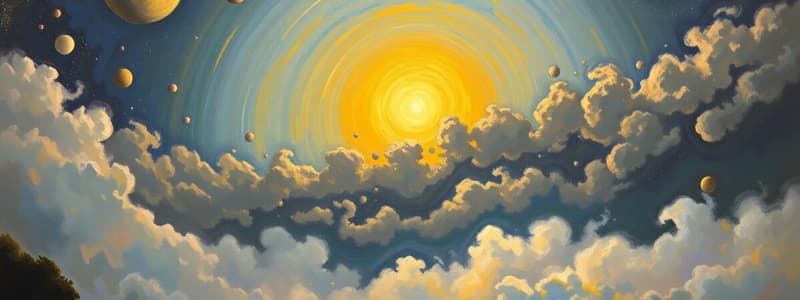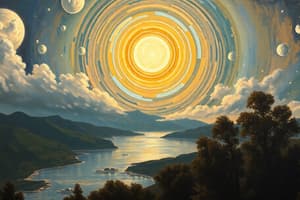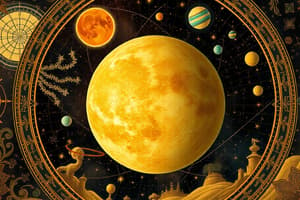Podcast
Questions and Answers
Which planet is known as the Red Planet?
Which planet is known as the Red Planet?
- Mars (correct)
- Jupiter
- Venus
- Mercury
What is the primary component of the Sun's gases?
What is the primary component of the Sun's gases?
- Oxygen
- Hydrogen (correct)
- Carbon dioxide
- Nitrogen
Which planet has the thickest atmosphere filled with carbon dioxide?
Which planet has the thickest atmosphere filled with carbon dioxide?
- Venus (correct)
- Neptune
- Jupiter
- Earth
How long does it take Mercury to complete one revolution around the Sun?
How long does it take Mercury to complete one revolution around the Sun?
Which planet is categorized as a gas giant and is the largest in the solar system?
Which planet is categorized as a gas giant and is the largest in the solar system?
What characterizes Uranus's rotation compared to other planets?
What characterizes Uranus's rotation compared to other planets?
Which planet has the most known moons?
Which planet has the most known moons?
What fraction of Earth’s surface is covered in water?
What fraction of Earth’s surface is covered in water?
Which planet is the furthest that can be seen without a telescope?
Which planet is the furthest that can be seen without a telescope?
Which gas is present in the atmosphere of Mars?
Which gas is present in the atmosphere of Mars?
Flashcards are hidden until you start studying
Study Notes
The Solar System
- The solar system includes the Sun, eight planets, their moons, and various celestial objects.
- The eight planets are Mercury, Venus, Earth, Mars, Jupiter, Saturn, Uranus, and Neptune.
The Sun
- The Sun is the center of the solar system, necessary for life on Earth.
- It is a sphere of primarily hydrogen and helium gases, emitting heat and light.
- The Sun is approximately 150 million kilometers away from Earth.
Mercury
- Mercury is the smallest and closest planet to the Sun.
- It is the fastest planet in orbit, completing a revolution in just 88 days.
Venus
- Venus is the second planet from the Sun and the hottest in the solar system.
- Its atmosphere is thick with carbon dioxide and contains clouds of sulfuric acid.
- Venus is the second brightest object in the night sky.
Earth
- Earth, known as the Blue Planet, is the third planet from the Sun and the only one with known life.
- Approximately three-quarters of Earth is covered with water.
- One full rotation takes about 24 hours, and it takes over 365 days to orbit the Sun.
Mars
- Mars, the fourth planet from the Sun, is often referred to as the Red Planet.
- It has water ice, is cold and rocky, and has a thin atmosphere composed mainly of carbon dioxide and oxygen.
- Mars has two known moons.
Jupiter
- Jupiter is the fifth planet and the largest in the solar system, categorized as a gas giant.
- It is the third brightest object in the sky, possessing at least 67 moons.
Saturn
- Saturn follows Jupiter as the sixth planet and is also a gas giant with over 60 moons.
- It is the furthest planet visible from Earth without a telescope.
Uranus
- Uranus, the seventh planet, is a gas giant smaller than Jupiter and Saturn.
- It is characterized by its blue clouds and unique sideways rotation due to its tilt.
Neptune
- Neptune is the eighth planet from the Sun and, like Uranus, is a gas giant with a blue appearance.
- It has thin rings and at least 14 known moons.
- Neptune takes over 164 years to complete one orbit around the Sun, the longest of all planets.
The Solar System
- Composed of the Sun, eight planets, their moons, and other celestial objects.
- Planets in order from closest to the Sun: Mercury, Venus, Earth, Mars, Jupiter, Saturn, Uranus, and Neptune.
The Sun
- Central star of the solar system, essential for life on Earth.
- Primarily made of hydrogen and helium gases, producing heat and light through nuclear fusion.
- Located approximately 150 million kilometers from Earth, known as an astronomical unit (AU).
Mercury
- Smallest planet and closest to the Sun.
- Fastest orbiting planet, completing a revolution in 88 Earth days.
Venus
- Second planet from the Sun, characterized as the hottest in the solar system.
- Thick atmosphere rich in carbon dioxide, with clouds containing sulfuric acid.
- Radiates brightness, making it the second brightest object in the night sky.
Earth
- Known as the Blue Planet, it is the third planet from the Sun and the only one known to support life.
- Approximately 75% of Earth is covered by water, crucial for sustaining life.
- Completes one rotation in about 24 hours and takes over 365 days to orbit the Sun.
Mars
- Fourth planet known as the Red Planet due to its iron oxide surface.
- Contains water ice, has a cold and rocky surface, and a thin carbon dioxide-rich atmosphere.
- Hosts two known moons, Phobos and Deimos.
Jupiter
- Fifth planet and the largest in the solar system, classified as a gas giant.
- Notable for its Great Red Spot, a massive storm, and its vibrant cloud bands.
- Has at least 67 moons, including the four largest known as the Galilean moons: Io, Europa, Ganymede, and Callisto.
Saturn
- Sixth planet from the Sun, also a gas giant, recognized for its prominent ring system.
- Home to over 60 moons, including Titan, which is larger than the planet Mercury.
- Furthest planet visible from Earth without a telescope.
Uranus
- Seventh planet, categorized as a gas giant but smaller than Jupiter and Saturn.
- Notable for its blue color due to methane in the atmosphere, and extreme axial tilt resulting in unique sideways rotation.
Neptune
- Eighth planet from the Sun, shares characteristics with Uranus as a gas giant with a blue hue.
- Features faint rings and at least 14 known moons, including Triton, which is geologically active.
- Takes over 164 Earth years to complete a single orbit around the Sun, the longest orbital period of all the planets.
Studying That Suits You
Use AI to generate personalized quizzes and flashcards to suit your learning preferences.



